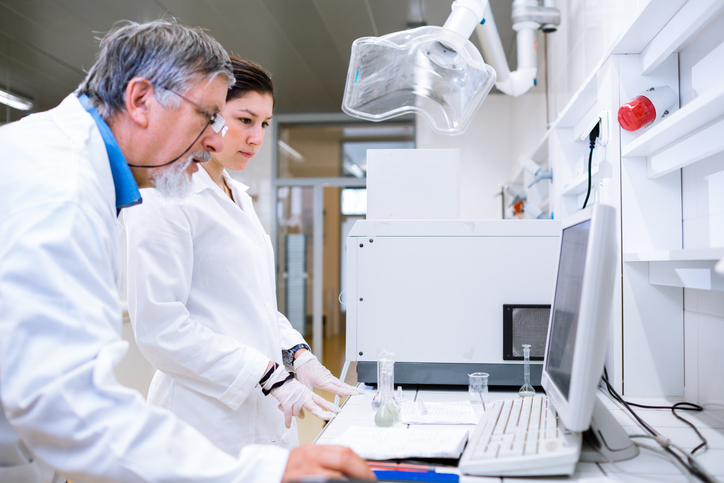3 Benefits Of Improving Mixing Efficiency In Your HPLC

What if you could dramatically improve the performance of your current gradient High Performance Liquid Chromatography (HPLC) system and achieve the best sensitivity possible, simply by installing one relatively inexpensive static mixing component?
Recent advancements in static mixer design make this possible – and affordable.
Reducing baseline noise to deliver the best sensitivity possible
Excessive baseline noise inhibits the ability of liquid chromatograms to detect analytes and impurities at very low levels. To address this issue, Mott recently introduced a large internal volume mixer (150µL) that provides the highest level of mixing efficiency in the industry while exceeding 99% reduction in baseline ripple to deliver the greatest possible signal-to-noise ratios.
These improved ratios offer significantly lower detection limits. For example, in skin cancer research studies, Mott’s static mixer can reduce the detection limits of Oxaliplatin, used in mucosal and skin cancer treatments, from 100 ng/mL down to 20 ng/mL.
Better mixing performance translates into greater throughput and a quicker return on your chromatograph investment
These static mixing components are ideal for research, analytical testing, production and quality control in the pharmaceutical, biomedical and food industries, in forensics and environmental monitoring, and for manufacturing process control.
Compared to standard mixers produced only a few years ago, today’s state-of-the-art static mixers deliver optimal phase mixing with lower internal volumes. Lower system dwell volume mixers – as much as 75% lower than standard mixers, generate cleaner signal responses, resulting in significantly better quantitation through first time integration of minor peaks, and reduce testing times considerably. Faster first time results enable your teams to conduct far more tests in a specific time period. In light of the fact that you have invested tens of thousands of dollars in your HPLC systems, more uptime translates directly into a faster return on your investment.
When one mixer can accommodate a range of flows, you benefit from lower costs
One advanced static mixer can now accommodate flow ranges of 0.1 ml/minute to 5 ml/minute, where, in the past, industry-standard mixers typically required three to five mixers per range. That simply means you benefit by spending less on these components.
And, because these modern-day static mixers are constructed of durable stainless steel that is rendered inert through passivation, there is never any metal ion contamination, so your system requires less frequent preventative maintenance and operates for longer periods between replacements, resulting in less overall downtime.
Update your existing HPLC systems to achieve better performance
Mott’s patent-pending PerfectPeakTM inline static mixers are designed to accommodate internal volumes ranging from 30 µL to 180 µL and can easily retrofit to your existing HPLC/UHPLC systems. They are also available as OEM installed components.
If you’d like to learn how these components can improve your existing HPLC system or give your future HPLC system a competitive advantage, contact us today. For in-person meetings, we will be exhibiting at Pittcon on March 5th through March 9th in booth #1438.
For more details and in-depth visuals, read Mott’s white paper entitled Reducing HPLC/UHPLC System Noise and Volume Using 3D Printed, High Performance Static Mixers.
FAQs: HPLC
Q: What is HPLC?
A: HPLC, or High Performance Liquid Chromatography, is a highly efficient analytical technique used to separate, identify, and quantify each component in a mixture. It relies on a liquid solvent to pass a sample mixture through a column filled with a solid adsorbent material, utilizing high pressure to facilitate the separation process.
Q: How does HPLC work?
A: HPLC works by injecting a small volume of the sample mixture into a stream of solvent (mobile phase) under high pressure. The mixture travels through a column containing stationary phase material, where different components of the mixture travel at different rates due to variations in their interactions with the stationary phase. This allows for the separation of components, which can then be detected and quantified.
Q: What is an HPLC method?
A: An HPLC method refers to the specific procedure or set of parameters used in an HPLC analysis, including the choice of mobile phase composition, column type, flow rate, temperature, and detection method. The method is developed to optimize the separation, detection, and quantification of specific substances within a sample.
Q: What are the main types of HPLC?
A: The main types of HPLC include Normal Phase HPLC, where the stationary phase is polar and the mobile phase is non-polar; Reverse Phase HPLC, which uses a non-polar stationary phase and a polar mobile phase; and Size Exclusion HPLC, which separates molecules based on size. Other types include Ion Exchange HPLC and Affinity HPLC, which target specific interactions between the analytes and the stationary phase.
Q: Why is HPLC preferred over other chromatographic techniques?
A: HPLC is preferred for its high resolution, speed, and accuracy in separating and analyzing complex mixtures. Its ability to handle a wide range of sample types, combined with its sensitivity and specificity, especially when coupled with various detectors, makes it a versatile tool in analytical chemistry.
Q: Can HPLC analyze both liquid and solid samples?
A: Yes, HPLC can analyze both liquid and solid samples. Solid samples must be dissolved in a solvent to create a solution that can be injected into the HPLC system. The choice of solvent depends on the sample’s solubility and the HPLC method being used.
Q: What industries use HPLC?
A: HPLC is widely used in various industries, including pharmaceuticals for drug analysis, environmental testing for pollutant detection, food and beverage for quality control, and in clinical labs for biomarker research. It’s also utilized in the chemical industry for product purity testing and in academic research for studying complex biological matrices.